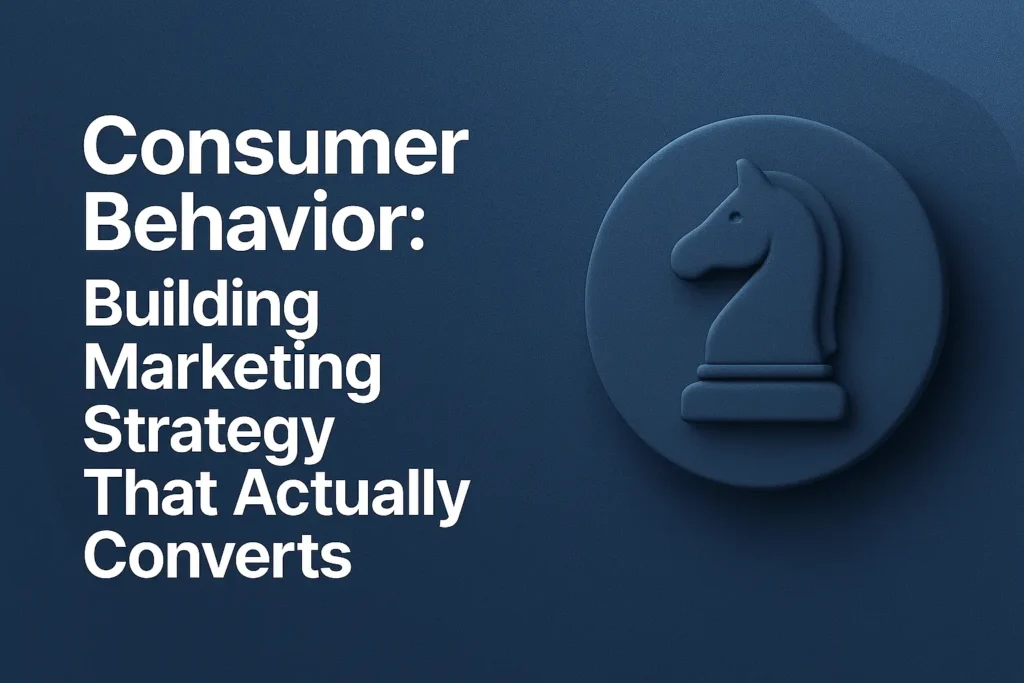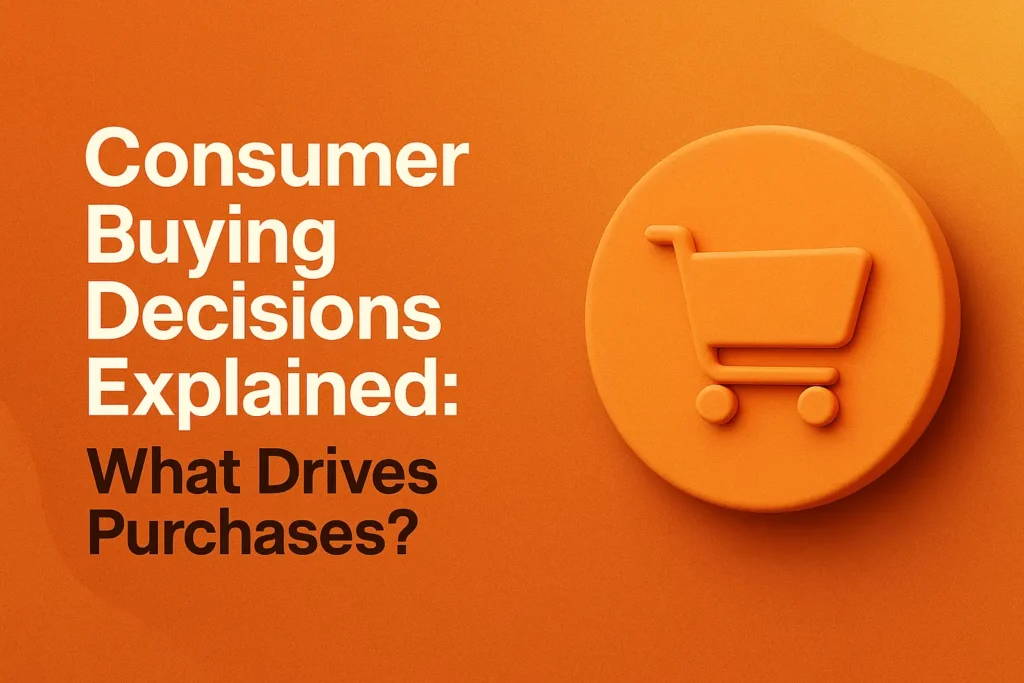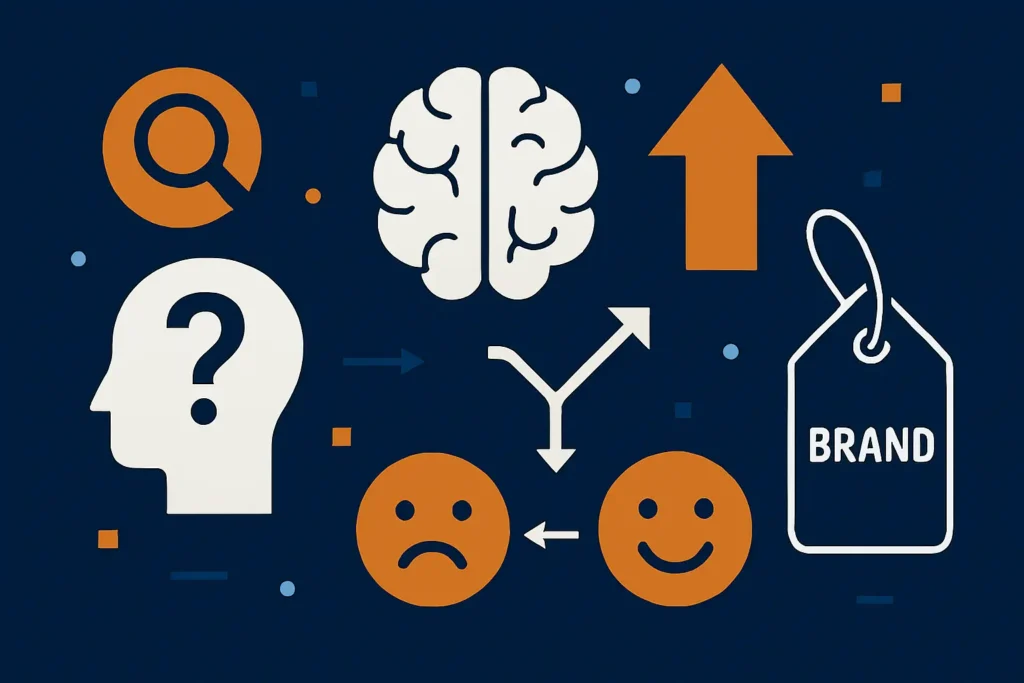Consumer behavior drives every successful marketing campaign, yet most businesses barely scratch the surface of what makes their customers tick. Understanding consumer behavior isn’t just about demographics or surface-level preferences—it’s about decoding the complex psychological, social, and economic factors that influence purchasing decisions at every touchpoint.
The most successful companies like Amazon, Netflix, and Apple have built their entire marketing ecosystems around deep consumer behavior insights, creating strategies that feel almost predictive. They don’t just respond to consumer needs; they anticipate them, sometimes before consumers themselves realize what they want.

Table of Contents
The Psychology Behind Consumer Decision-Making
Modern consumer behavior operates on multiple psychological layers that traditional marketing approaches often miss. Cognitive biases, emotional triggers, and subconscious motivations play far more significant roles in purchase decisions than rational evaluation of product features.
Emotional Processing vs. Rational Evaluation
Research from neuroscience reveals that emotional processing occurs milliseconds before rational thought. When consumers encounter marketing messages, their limbic system processes emotional cues before their prefrontal cortex evaluates logical benefits. This explains why brands like Coca-Cola focus on emotional associations rather than product specifications in their marketing communications.
The most effective marketing strategies leverage this by creating emotional anchors first, then supporting them with rational justifications. Tesla exemplifies this approach—their marketing creates emotional connections to innovation and environmental consciousness, while providing rational justifications through performance metrics and cost savings.
Social Proof and Herd Mentality
Social validation remains one of the strongest drivers of consumer behavior. However, the modern interpretation goes beyond simple testimonials. Consumers now seek authentic social proof through user-generated content, peer reviews, and community engagement.
Spotify’s “Wrapped” campaign demonstrates sophisticated social proof marketing. By providing personalized listening statistics, they encourage users to share their music preferences, creating authentic social proof while strengthening brand engagement. This approach transforms customers into active marketing participants rather than passive recipients.
Data-Driven Consumer Behavior Analysis
The digital age has revolutionized how businesses can understand and predict consumer behavior. Advanced analytics, machine learning algorithms, and real-time data processing enable unprecedented insights into consumer patterns.
Behavioral Segmentation Beyond Demographics
Traditional demographic segmentation provides limited insights compared to behavioral segmentation based on actual consumer actions. Behavioral data reveals how consumers interact with brands across multiple touchpoints, providing actionable insights for marketing strategy development.
Netflix uses behavioral segmentation to create highly personalized marketing experiences. Rather than relying on age or location data, they analyze viewing patterns, completion rates, and interaction behaviors to predict content preferences and customize marketing messages accordingly.
Predictive Analytics in Consumer Behavior
Machine learning algorithms can now identify patterns in consumer behavior that human analysts might miss. These insights enable proactive marketing strategies that anticipate consumer needs rather than simply responding to expressed preferences.
Amazon’s recommendation engine processes billions of data points to predict consumer behavior with remarkable accuracy. Their “customers who bought this also bought” feature isn’t just showing related products—it’s demonstrating deep understanding of consumer behavior patterns and purchase correlations.
Building Consumer-Centric Marketing Strategies
Effective marketing strategies built on consumer behavior insights require systematic approaches that integrate psychological understanding with data-driven decision making.
The Consumer Journey Mapping Revolution
Modern consumer journeys are complex, non-linear paths that span multiple channels and touchpoints. Understanding these journeys requires mapping not just what consumers do, but why they do it at each stage.
Successful consumer journey mapping identifies emotional states, motivations, and pain points at every interaction. This approach enables marketing strategies that provide value at the right moments rather than interrupting with irrelevant messages.
Salesforce has mastered this approach by creating detailed customer journey maps that account for both digital and offline touchpoints. Their marketing automation responds to behavioral triggers in real-time, delivering personalized experiences that feel natural rather than automated.
Psychological Triggers in Marketing Strategy
Understanding consumer psychology enables the strategic use of psychological triggers that influence behavior without feeling manipulative. These triggers, when used ethically, create win-win scenarios where consumers receive genuine value while businesses achieve their marketing objectives.
Scarcity and Urgency
Scarcity creates urgency by triggering loss aversion—the psychological principle that people feel losses more intensely than equivalent gains. However, artificial scarcity can damage brand trust if consumers detect manipulation.
Effective scarcity marketing uses genuine limitations to create urgency. Supreme’s limited product releases create authentic scarcity that drives demand while maintaining brand exclusivity. Their marketing strategy leverages scarcity psychology without resorting to false limitations.
Social Identity and Belonging
Consumers make purchases that align with their desired identity and social group memberships. Marketing strategies that tap into identity needs create stronger emotional connections than those focused solely on functional benefits.
Patagonia’s marketing strategy explicitly targets consumers who identify with environmental consciousness and outdoor adventure. Their campaigns reinforce customer identity while promoting products, creating marketing messages that feel like community building rather than sales pitches.
Cross-Cultural Consumer Behavior Considerations
Global marketing strategies must account for cultural differences in consumer behavior. What motivates consumers in individualistic cultures may not resonate in collectivistic societies, and marketing approaches must adapt accordingly.
Cultural Dimensions in Consumer Psychology
Hofstede’s cultural dimensions theory provides frameworks for understanding how cultural values influence consumer behavior. Power distance, individualism versus collectivism, and uncertainty avoidance significantly impact how consumers respond to marketing messages.
McDonald’s demonstrates cultural adaptation in their marketing strategies. In India, they emphasize family values and vegetarian options, while in Germany, they focus on quality and efficiency. These approaches reflect deep understanding of cultural consumer behavior differences.
Localization vs. Standardization
The challenge for global brands lies in balancing consistent brand identity with localized consumer behavior understanding. Successful strategies maintain core brand values while adapting execution to local consumer preferences and behaviors.
Digital Transformation of Consumer Behavior
Digital technologies have fundamentally altered consumer behavior patterns, creating new opportunities and challenges for marketing strategists.
Omnichannel Consumer Expectations
Modern consumers expect seamless experiences across all channels, with consistent messaging and unified customer service. Their behavior patterns now span online research, social media validation, mobile comparison shopping, and offline purchase experiences.
Disney has created one of the most sophisticated omnichannel experiences, integrating their parks, streaming service, merchandise, and mobile apps into a unified consumer experience. Their marketing strategy recognizes that consumer behavior rarely fits into single-channel patterns.
Mobile-First Consumer Behavior
Mobile devices have become the primary interface for consumer-brand interactions, fundamentally changing how consumers discover, research, and purchase products. Marketing strategies must account for mobile-specific behavior patterns and preferences.
TikTok’s algorithm leverages mobile-first consumer behavior by creating highly engaging, personalized content streams that keep users engaged for extended periods. Their advertising platform allows brands to integrate seamlessly with user-generated content, creating marketing experiences that feel native to the platform.
Measuring Consumer Behavior Impact
Effective marketing strategies require robust measurement systems that track both immediate conversions and long-term behavioral changes.
Advanced Attribution Modeling
Traditional last-click attribution models fail to capture the complexity of modern consumer behavior journeys. Advanced attribution models account for multiple touchpoints and their relative influence on final purchase decisions.
Google’s attribution modeling tools help businesses understand how different marketing channels contribute to consumer behavior changes throughout the purchase journey. This data enables more sophisticated budget allocation and strategy optimization.
Behavioral Cohort Analysis
Cohort analysis reveals how consumer behavior evolves over time, enabling marketing strategies that account for changing preferences and needs. This approach provides insights into customer lifetime value and retention strategies.
Real-Time Behavioral Adaptation
Modern marketing platforms enable real-time adaptation based on consumer behavior signals. This capability allows marketing strategies to evolve dynamically rather than relying on static campaigns.
Uber’s surge pricing algorithm demonstrates real-time behavioral adaptation, adjusting prices based on supply and demand patterns while communicating transparently with consumers about pricing factors.
Ethical Considerations in Consumer Behavior Marketing
Understanding consumer psychology creates powerful marketing capabilities, but also raises ethical responsibilities about how these insights are used.
Transparency vs. Manipulation
Effective marketing strategies can influence consumer behavior without being manipulative. The key lies in creating genuine value while respecting consumer autonomy and decision-making processes.
Ethical marketing strategies use behavioral insights to provide better customer experiences rather than exploit psychological vulnerabilities. This approach builds long-term trust and brand loyalty while achieving business objectives.
Privacy and Data Usage
Consumer behavior analysis requires extensive data collection, raising important privacy considerations. Marketing strategies must balance behavioral insights with respect for consumer privacy preferences.
Apple’s approach to privacy-focused marketing demonstrates how brands can build trust while still creating effective marketing strategies. Their emphasis on privacy protection has become a competitive advantage and marketing differentiator.
Future Trends in Consumer Behavior Marketing
Emerging technologies and changing social patterns are creating new opportunities for consumer behavior-based marketing strategies.
Artificial Intelligence and Personalization
AI technologies enable unprecedented personalization capabilities, allowing marketing strategies to adapt to individual consumer behavior patterns in real-time. This technology will make mass customization increasingly accessible to businesses of all sizes.
Voice and Conversational Commerce
Voice assistants are creating new consumer behavior patterns around search, discovery, and purchase processes. Marketing strategies must adapt to conversational interfaces and voice-optimized content.
Sustainability and Values-Based Consumption
Consumer behavior increasingly reflects values-based decision making, with environmental and social impact considerations playing larger roles in purchase decisions. Marketing strategies must authentically align with consumer values rather than superficially appealing to trends.
Implementation Framework for Consumer Behavior Marketing
Successfully implementing consumer behavior insights requires systematic approaches that integrate research, strategy development, and continuous optimization.
Research and Data Collection
Effective consumer behavior analysis combines qualitative insights with quantitative data. Surveys, interviews, focus groups, and observational research provide context for behavioral data patterns.
Strategy Development Process
Consumer behavior insights must translate into specific marketing actions. This requires frameworks that connect behavioral understanding to tactical execution across all marketing channels.
Testing and Optimization
Consumer behavior patterns evolve continuously, requiring marketing strategies that adapt through systematic testing and optimization. A/B testing, multivariate analysis, and behavioral experiments enable data-driven strategy refinement.
Performance Measurement
Measuring the impact of consumer behavior-based marketing strategies requires metrics that go beyond immediate conversions to include engagement, retention, and long-term customer value.
Final Thoughts
Consumer behavior represents the foundation upon which all effective marketing strategies must be built. The brands that succeed in today’s competitive landscape are those that move beyond surface-level demographic targeting to understand the deep psychological, cultural, and behavioral factors that drive consumer decisions.
The integration of behavioral psychology with advanced data analytics creates unprecedented opportunities for marketing precision and effectiveness. However, this power comes with responsibilities to use consumer insights ethically and transparently.
As consumer behavior continues evolving with technological advancement and cultural change, marketing strategies must maintain flexibility while staying grounded in fundamental psychological principles. The future belongs to brands that can anticipate and adapt to consumer behavior changes while maintaining authentic relationships with their customers.
The investment in understanding consumer behavior pays dividends not just in marketing effectiveness, but in creating genuine value for customers and building sustainable business growth. Marketing strategies built on deep consumer behavior insights create competitive advantages that are difficult for competitors to replicate because they reflect authentic understanding rather than superficial tactics.
Read More: Consumer Buying Decisions Explained: What Drives Purchases?


